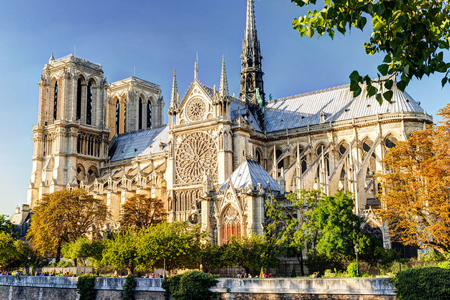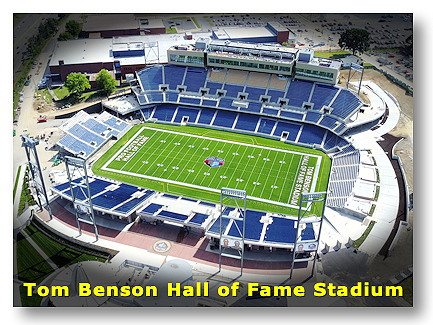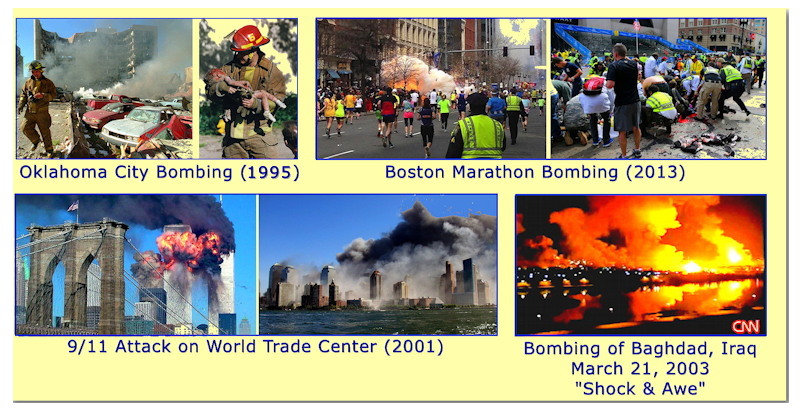This page was last modified on October 15, 2024
PSY 355 Psychology
& Media in the Digital Age
This page was last modified on October 15, 2024 |
Class 16: The Notion of "The Spectacle" • Living in the World of the Spectacle
Different types of spectacles within cultures tend to reinforce the basic values of that culture.
Ancient Roman spectacles included (Cartwright, 2013)
· Chariot Races (“ludi circenses”)
· Gladiator Contests (“munera”)
· Wild Animal Hunts (“venatio”)
· Triumphs (“triumphi”), Processions (“pompae”), and Re-enacted Naval Battles (“naumachia”)
· Theatrical Performances (“ludi scaenici”)
· Public Executions (“summum supplicium”) including crucifixions, burnings, and being thrown to animals.
These forms of entertainment helped to provide an “audience with an escape from the boredom of their daily routines” (Coleman, 1990, p. 59)
Frequency: Under Augustus (emperor 27 BCE-14 CE), public entertainments were presented on 77 days of the year; by the reign of Marcus Aurelius (emperor 161-180 CE), the number of days had expanded to 135 {W}
Roman values in the spectacles
- Warrior spirit of the founding myths
- Superiority of Rome over others
- Strict social hierarchy
- Criminals need to be degraded & humiliated
Spectacles in Christian Europe

Religious pageants & processions: Feast of Corpus Christi ("Body of Christ") in June, Carnival/Mardi Gras in late winter, Easter, local feasts of the saints in individual villages, towns, & cities
Church architecture as offering vivid sights for people who otherwise lived in plain homes
Christian values in the spectacles
- God's Glory & Majesty
- The divine working via Jesus Christ within human lives: salvation, redemption
- Hierarchy in society
The Nuremberg Rallies (Nazi Germany, 1933-1938)
- "The Cathedral of Light was a main aesthetic feature of the Nazi Party rallies in Nuremberg starting in 1933. It consisted of 130 anti-aircraft searchlights, at intervals of 12 meters, aimed skyward to create a series of vertical bars surrounding the audience. The effect was a brilliant one, both from within the design and on the outside. The cathedral of light was documented in the Nazi Propaganda film Festliches Nürnberg, released in 1937” [https://rarehistoricalphotos.com/nazi-rally-cathedral-light-c-1937/]
- “Triumph of the Will (German: Triumph des Willens) is a 1935 Nazi propaganda film directed, produced, edited, and co-written by Leni Riefenstahl. It chronicles the 1934 Nazi Party Congress in Nuremberg, which was attended by more than 700,000 Nazi supporters” [Wikipedia, 20210405]
- The film showed German military power & strength: eagles & Swastikas: reminiscent of the Roman Legions from the ancient world.
- Emphasis upon the unity of the German People: everything shown in perfect alignment, marching in identical step
- Showed many Germans in peasant clothing and costume linking the Germans of the 1930s with their ancestorss
- Torchlight processions as reminiscent of medieval celebrations in German cities and towns
Victory Parades in Red Square (Moscow, Soviet Union; 1945 and after)
For many years from May 1945 onward the USSR celebrated victory over Nazi Germany (until the collapse of the Soviet Union in 1991). These celebrations involved major military parades in Red Square, the enormous plaza (230 by 1,083 feet) in front of the Kremlin, the seat of the government, in Moscow. Thousands of Russian soldiers and sailors marched in perfect formation while military equipment, including new ballistic missiles, rolled through the square as government and military officials watched from the Kremlin Wall.
1945 1960 1970
In May 2019 Russians witnessed one of the most elaborate Victory Day Parades in Red Square, an event broadcast on Russian television networks which showed President Putin, military heroes of the past, and ordinary citizens watching an almost endless stream of soldier and sailors. It was billed as the "74th Anniversary of Victory in the Great Patriotic War of 1941-1945".
These Moscow Victory Parades--grand spectacles in a hallowed space--have reflected multiple values of Soviet and Russian culture and history including
- national strength and determination
- honoring the role of countless "ordinary" people in achieving victory
- strong historical memories of the sacrifices the nation endured in the war (over 20 million Soviet citizens died)
The Spectacle in Contemporary Society
A. Debord's Notion of "The Spectacle"
Guy Debord (1967/1994) argues that we live in a "media and consumer society, organized around the production and consumption of images, commodities, and staged events" (Kellner, 2003). Such a society is
- strongly connected to the notion of separation and passivity ("For Debord, the spectacle is a tool of pacification and depoliticization; it is a "permanent opium war" (#44) which stupefies social subjects and distracts them from the most urgent task of real life -- recovering the full range of their human powers through creative practice" Kellner, 2003) and,
- uses "the cultural mechanisms of leisure and consumption, services and entertainment, ruled by the dictates of advertising and a commercialized media culture" (Kellner, 2003)
Values of contemporary society
- Competition
- Winning
- Success
- Wealth & Money
- Leisure
Major Examples of Spectacle in today's world (Kellner, 2003)
- Sports (Olympics, World Series, Super Bowl, March Madness-NCAA Basketball)
- Sports Stadiums: filled with electronic reproduction of the action & advertisements.
Both professional sport teams and, even, high school football
• Professional stadiums
- SoFi Stadium (Inglewood, CA • LA Rams; image above)
- Built at a cost of over $5 billion (the most expensive in the world) with 100,000 seats
- Infinity Screen (Samsung): an ovular, double-sided 4K high dynamic-range video hung from the room above the field and displaying 80 million pixels, housing a 26-speaker audio system, and 56 5G wireless antennas.
- Will host a variety of events year round including Super Bowl LVI in 2022, WrestleMania 39 and the College Football Championship Game in 2023, and the Opening and Closing Ceremonies of the Olympic Games in 2028 as well as multiple rock concerts.
• High school stadiums

- Tom Benson Hall of Fame Stadium –– McKinley HS ($137 million, 23,000 seats, reconstructed 2015-16, image above)
- Cypress-Fairbanks FCU Stadium — Cypress, TX ($69 million, 11,000 seats, 2006)
- Legacy Stadium — Katy, TX ($70,000, 12,000 seats, 2017)
- McKinney ISD Stadium — McKinney, TX ($70 million, 12,000 seats, 2018)
- Eagle Stadium — Allen, TX ($60 million, 18,000 seats, 2012)
- Film (Glamour, fashion, excess)
- Comic Books & Films (heroes, fantasy figures of power: today transformed into major Superhero film franchises such as Spider-Man, Batman, Captain America, Guardians of the Galaxy, The Avengers, Wonder Woman, X-Men, Black Panther, Luke Cage, etc.)
- Television (sports, election coverage, "reality" TV, competitive shows, sex-dating shows)
- Pop music (glamour, beauty, sexuality)
- Musical Concerts as extravaganzas
- Video & computer games
- Erotic & Merchandised Sexuality (soft & hardcore porn in multiple media)
- Politics (campaigns, governing as continued campaigns...; see Question #2 below)
- Terrorism (9/11, "shock & awe" bombing, ISIS, Boko Haram...) see below
Note that the major players in creating "The Spectacle" (that is, celebrities) are quite well paid and often have immense wealth
B. Terrorism as Spectacle: Domestic and Foreign • Psychological Effects
We live in a world in which terrorism has become more and more prevalent. While there are conflicting definitions of the word "terrorism" here are definitions used by the FBI in the US for two forms of terrorism:
International terrorism: Violent, criminal acts committed by individuals and/or groups who are inspired by, or associated with, designated foreign terrorist organizations or nations (state-sponsored), and,Notice that these definitions do not include mass murder events in which perpetrators act without any ideological goals.
Domestic terrorism: Violent, criminal acts committed by individuals and/or groups to further ideological goals stemming from domestic influences, such as those of a political, religious, social, racial, or environmental nature.
The growth of terrorism over the last fifty years can be seen in this chart of the number of deaths worldwide attributed to terrorist activities:
Most of the deaths attributed to terrorism have NOT occurred in the United States. The majority of such deaths have happened in Africa and Asia. Nonetheless, the United States has had its own experiences of domestic terrorism including
- 1995 (April 19) bombing of the Oklahoma City Federal Building by the American citizen, Timothy McVeigh which resulted in 168 dead (19 children included) and many hundred of injuries
- 9/11/2001. Four coordinated attacks by hijacked jet planes which hit the World Trade Center in NYC, the Pentagon in DC, and the foiled attack that ended in Shanksville, PA. (YouTube Video from NBC News [distrubing content]). The perpetrators involved 19 men in three teams of 5 and one team of 4. Excluding the hijackers, the total number of those killed was 2,977 and over 6,000 injured (though additional deaths due to exposure to carcinogens by rescuers continue to add up), and
- Boston Marathon Bombing (April 15, 2013) near the finish line. The attack was done by two brother terrorists with the result of 3 killed and hundreds injured.
In response to the attacks on 9/11, the United States went to war in both Afghanistan (begun 2001 and ended 2021) and Iraq (begun 2003 and ended 2017). The cost of these wars is estimated at $5 trillion.
- Bombing of Baghdad, Iraq (March 21, 2003) "Shock and Awe" [YouTube Video]

As seen in the images above, an central aspect to contemporary terrorism has been the presence of visual media recording both the acts perpetrated by the terrorists and the response of the government to such events. Notice what these images above demonstrate:
- All of the events illustrated above were seen by large television audiences live either immediately after the initial attack or, even, during subsequent attacks themselves.
- The Federal Building in Oklahoma City was mostly destroyed at 9:02 am on April 19, 1996. Television stations across the US quickly switched to show the demolished front of the Federal Building from both helicopters and ground crews who could transmit live images
- While the attack on the first World Trade Center building on 9/11 at 8:46 am was not witnessed on television, the second attack at 9:03 am was seen live and, subsequently, the collapse of both towers was also shown live. A video recording of the first attack was aired by television stations within an hour of that event.
- The Boston Marathon itself is a televised event in New England and the 2013 bombing at the finish line was seen by audiences there and, immediately thereafter, by a national audience.
- When the United States began its war on Iraq on March 21, 2003, American news channels including CNN had reporters and transmission facilities in the capital, Baghdad. Hence, when the US began bombing the capital that night, viewers in the United States and across the world witnessed that attack whose ferocious and overwhelming size was intended to cause "shock and awe" among the Iraqi military and political leadership.
- In each case the television coverage was non-stop for many hours and, even, days. Viewers in the United States and worldwide could spend most of their free time watching this continued coverage from their living rooms or bedrooms.
- The video recordings of the attacks were played repeatedly so that viewers may have literally watched each event or scene dozens of times.
Potential Psychological Effects of the "Terrorism Spectacle"
- The experience of witnesses, rescue workers, and television viewers to terrorist-inspired scenes has resulted in various psychological and psychiatric research on the potential mental health effects of the experience. Such effects might include major depressive disorder (MDD), post-traumatic stress disorder (PTSD), and other stress and anxiety disorders.
- Note that the Diagnostic & Statistical Manual of Mental Disorders has required that the diagnosis of PTSD can only be given to an individual who was directly exposed to the trauma in person or had that trauma harming their immediate family. Thus, there has been a significant question whether PTSD itself can develop after watching video images on a television screen.
- Mental health effects of 9/11 viewing: "Taken together, the data from the three large-scale WTC telephone interview surveys suggest that exposure to emotionally charged, real-life television images of death and destruction can produce symptoms of PTSD and MDD in children and adults. Vulnerable persons who have other known risk factors, such as women, minority group members, and those with prior traumatic experiences, should exercise caution by limiting their viewing of violent television programs, including news reports." (Eth, 2002, p. 302)
- Robert et al. (2021) summarize the research literature as showing that:
The 24-hour media cycle (including television, newspapers, and social media) turns local disasters into national and international tragedies or “collective trauma.” Prior research demonstrates that, following these events, many in the general population are repeatedly exposed to images of brutal violence through widespread media coverage A number of studies following terrorist attacks in the United States demonstrated that this media exposure may have implications for mental health, with post-traumatic stress symptoms (PTSS) as the most commonly assessed outcome. PTSS symptoms include the re-experiencing, avoidance, hyperarousal, and cognitive distortions that characterize Post-traumatic Stress Disorder (PTSD),but may be assessed in the absence of Diagnostic and Statistical Manual of Mental Disorders Criterion A (i.e., trauma exposure) for PTSD. Positive associations between time spent watching traumatic images on TV or the internet and PTSS have been reported in the general population at 1 month (6), 1 to 2 months, 6 months and even years after terrorist attacks.Note the use of the term Post-Traumatic Stress Symptoms (PTSS) rather than PTSD.
Social Media as Trauma-inducing
(based on Scott et al., 2023)
Expanding the notion of psychological harms due to terrorism as spectacle to the wider issue of social media as trauma inducing, consider the following:
Scott and her colleagues (2023) offer an overview of the notion of trauma as consisting of 11 different types (some of which are overlapping in their impact). Paralleling those non-media based types of trauma, social media itself can serve to create or augment the multiple types of trauma.
Types of Trauma
Examples
Forms of Social Media Trauma
Individual
Single events: mugging, rape, etc.
Online harassment; online public shaming or ridicule
Developmental
Child sexual abuse, youth food insecurity, elder abuse
Child exposure to inappropriate content; child pornography, fraud against elderly, human trafficking
Secondary & Vicarious
Witnessing/hearing about trauma: assault, murder, rape
Occupational burnout/stree dealing with traumatic materials; reacting to postings of others in distress
Interpersonal
Intimate partner violence (IPV), elder abuse
Unwanted messaging; hate messaging; victim blaming; giving IVP perpetrator greater control over abused partner
Group, Community, Collective
Firefighters losing teammate, school shootings
Vivid images of traumatic events live & unfiltered such as pandemic, murder victims, livestreaming terror attacks
Racial
Discrimination, threats of harm, humiliation, bias crimes or brutality against people of color
Racist speech (anti-Black, anti-woman, anti-Semiitc); sites denying racism or racially-inspired crime (murder of George Floyd)
Cultural
Eroding cultural heritage: prejudice, inequality in access to health care, education because of cultural background
Antisemitic tropes; Holocaust denial; parodies of cultural groups
Historical
Whole generation affected: the Holocaust
Historical & Broad-reaching Traumas
Natural
"acts of God": hurricanes, floods, earthquakes
Real time presentation of disasters; spreading misinformation
Restricting access to social media in emergenciesHuman-caused
Failures such as accidents; terrorism, technological failure (train derailment)
Mass
War, nuclear reactor meltdown in Ukraine; COVID-19?
Here are three questions to ask about Spectacle in the
Contemporary World:
1. Do you agree or not that the major values in our world today are competition, winning, success, wealth & money, and leisure? If not, what other values do we have in our culture that are equally or almost equally important?
2. Does the notion that spectacles are very important to people today help you understand how our political culture works? Can you think of ways in which political figures use spectacle to attract support from voters?
3. Is it possible that the rising rates of anxiety, depression, and other forms of psychological distress in today's world are related to or made more painful because people who watch spectacles compare themselves unfavorably with what they see? Or, as noted just above, people may be exposed to suffering via video images?
References
Ahern, J., Galea, S., Resnick, H., Kilpatrick, D., Bucuva;as. M., Gold, J., & Vlahov, D. (2002). Television images and psychological symptoms after the September 11 terrorist attacks. Psychiatry, 65(4), 289-300. https://dx.doi.org/10.1521/psyc.65.4.289.20240
Cartwright, M. (2013, December 04). Roman games, chariot races & spectacle. World History Encyclopedia. Retrieved from https://www.worldhistory.org/article/635/roman-games-chariot-races--spectacle/
Coleman, K. M. (1990). Fatal charades: Roman executions staged as mythological enactments. The Journal of Roman Studies, 80, 44-73. https://dx.doi.org/10.2307/300280
Debord, G. (1994) The society of the spectacle (Original title: La société du spectacle; D. Nicholson-Smith, Transl.). Brooklyn, NY: Zone Books. Originally published 1967.
Eth, S. (2002). Television viewing as risk factor (Commentary on Ahern et al., 2002). Psychiatry, 65(4), 301-303. https://dx.doi.org/10.1521/psyc.65.4.301.20245
Kellner, D. (2004, April-May). Media culture and the triumph of the spectacle. Razón y palabra, 39. http://www.razonypalabra.org.mx/anteriores/n39/dkelner.html
Robert, M., Stene, L. E., Garfin, D. R., Vandentorren, S., Montreff, U., du Roscoat, E., & Pirard, P. (2021). Media exposure and post-traumatic stress symptoms in the wake of the November 2015 Paris terrorist attacks: A population-based study in France. Frontiers in Psychiatry. https://dx.doi.org/10.3389/fpsyt.2021.509457
Scott, C. F., Marcu, G., Anderson, R. E., Newman, M. W., & Schoenbeck, S. (2023, April). Trauma-informed social media: Towards solutions for reducing and healing online harm. In Proceedings of the 2023 CHI Conference on Human Factors in Computing Systems (pp. 1-20). https://dl.acm.org/doi/pdf/10.1145/3544548.3581512